Exploring Ride Along Skid Steer Efficiency in Farming
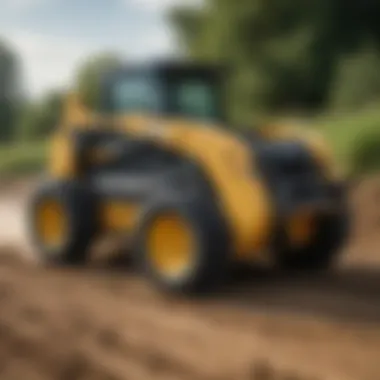
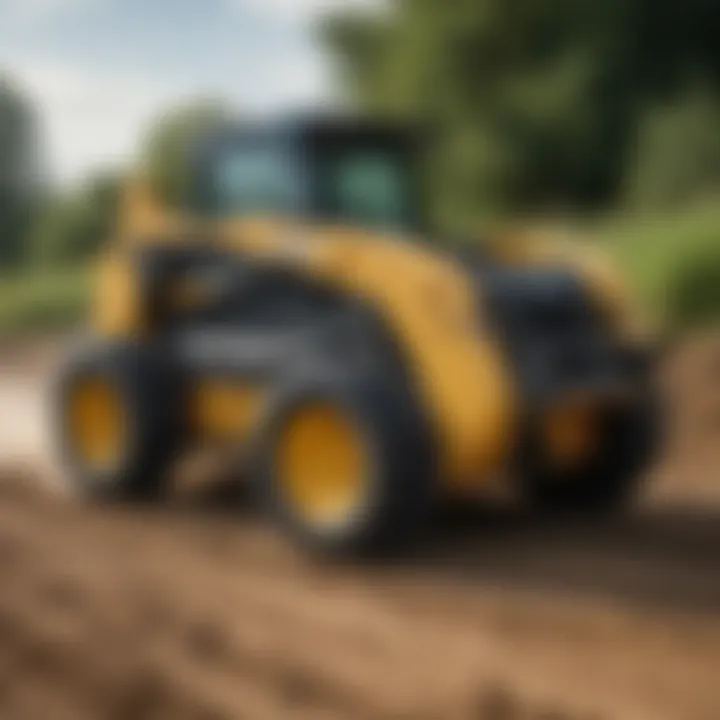
Intro
The demand for efficiency in agriculture has led to advances in equipment design and operations. Ride along skid steers have become essential tools on many farms. These machines can increase productivity and enhance safety while performing various tasks. Understanding how these machines operate can be critical for farmers and agricultural enthusiasts.
Overview of the Topic
Definition and Importance
Ride along skid steers are a type of compact construction equipment designed for versatility. They consist of a wheeled or tracked vehicle with a pivoting chassis. The operator rides in the vehicle, allowing for better control and visibility of the worksite. These machines are vital in numerous agricultural applications, including land clearing, soil preparation, and material handling.
With the agricultural sector continuously evolving, the importance of ride along skid steers increases. They provide solutions for labor shortages and can significantly reduce the time requirements for various tasks.
Current Trends
In recent years, the design of skid steers has improved significantly. Many machines now include advanced technology such as GPS and automation features. This technology can provide farmers with real-time data about productivity and efficiency.
Additionally, electric and hybrid skid steers are gaining attention. They offer a more environmentally friendly alternative without the emissions associated with diesel engines. These trends reflect changing priorities in agriculture towards sustainability and efficiency.
Key Techniques and Practices
Step-by-Step Guide
When using a ride along skid steer, several steps improve safety and efficiency:
- Preparation: Inspect the machine and ensure it is in good working condition.
- Training: Ensure all operators understand the controls and safety measures.
- Positioning: Set the machine in the correct position for the task, whether it be grading, loading, or lifting.
- Operation: Engage the controls with a focus on smooth movements to avoid sudden shifts that may cause accidents.
- Finishing: After tasks are completed, perform necessary maintenance and clean up the work area.
Tools and Equipment Needed
To enhance the performance of ride along skid steers, various attachments and tools can be used. These include:
- Buckets for loading and moving materials.
- Grapples for handling bulk products or debris.
- Palet forks for transporting pallets of goods.
Utilizing these tools can maximize the versatility and capabilities of skid steers across different tasks in the agricultural setting.
Challenges and Solutions
Common Obstacles
Like any equipment, ride along skid steers face challenges. Common problems may include:
- Mechanical failures due to lack of maintenance.
- Operator fatigue if not trained properly.
- Ground conditions that restrict movement or stability.
Innovative Solutions
To overcome these challenges, innovative solutions can be developed. Implementing regular maintenance schedules can ensure machines remain reliable. Training programs for operators can improve safety and efficiency. Moreover, using technology to monitor ground conditions can prevent accidents and ensure optimal performance.
Regular maintenance and proper training are not just good practices but essential for maximizing the potential of ride along skid steers in agriculture.
In summary, the role of ride along skid steers continues to grow in significance in the agricultural landscape. Understanding the intricacies of operation, safety, and ongoing trends will help enhance productivity and contribute to the industry's advancement.
Preamble to Ride Along Skid Steers
Ride along skid steers represent a significant advancement in agricultural machinery, offering unique advantages and operational efficiencies for farmers and agricultural businesses. Understanding their functionality and historical context can reveal not just their practical applications, but also the evolutionary trajectory that led to their current sophisticated forms.
Definition and Overview
Ride along skid steers are small, maneuverable machines designed for a variety of tasks on agricultural sites. They come equipped with tracks or wheels and feature a pivot steering mechanism, giving operators precise control while navigating tight spaces. The operator typically rides within an enclosed cabin or platform, providing a higher vantage point during operation.
These machines are versatile, capable of performing numerous tasks such as material handling, land preparation, and maintenance work. The compact design allows them to access areas that larger equipment cannot reach, making them an essential tool in modern farming.
Historical Development
The evolution of ride along skid steers traces back several decades. The first models were introduced in the 1960s, evolving from earlier designs focused primarily on wheeled loaders and tractors. Over the years, advancements in engine technology, hydraulic systems, and safety features transformed them into what we see today.
Initially, these machines were utilized for simple tasks within farm settings. However, growing demand for efficient farming methods led to their expansion in capabilities. As farmers looked for ways to boost productivity and streamline operations, manufacturers responded by introducing various attachments and modern features, turning skid steers into multifunctional tools.
With the rise of precision agriculture, the integration of technology within skid steers became a focal point. Innovations in automation and data analytics began appearing, broadening the scope of operations they could effectively support.
Understanding what ride along skid steers are and their historical significance allows stakeholders in agriculture to appreciate the role these machines play in enhancing productivity, efficiency, and safety within the sector.
"The evolution of ride along skid steers reflects the agricultural industry's commitment to adopting innovative solutions for effective farming practices."
Mechanics of Ride Along Skid Steers
Understanding the mechanics behind ride along skid steers is crucial for appreciating their role in modern agriculture. The efficiency and effectiveness of these machines rely heavily on their mechanical design and operations. This section will delve deep into the core components and governing principles that make ride along skid steers so valuable in various agricultural tasks.
Key Components
Engine Mechanisms
The engine mechanisms in ride along skid steers are integral to their performance. These engines are typically powerful diesel units designed to provide the necessary torque for demanding agricultural tasks. A significant characteristic of these engines is their ability to deliver consistent power across a wide range of speeds. This flexibility is crucial as it allows operators to adjust the speed and power output based on the specific task at hand.
One unique feature of the engine mechanisms is their compact design, which allows for more efficient space utilization within the skid steer. While diesel engines are generally known for their efficiency, they do have disadvantages, such as being heavier compared to alternatives like gasoline engines, which may affect the overall weight distribution of the skid steer.


Hydraulic Systems
Hydraulic systems serve as the backbone of ride along skid steers, allowing for precise control over the various attachments and movements of the machine. The hydraulics in these systems harness the power generated by the engine, converting it into the force needed to lift, tilt, and maneuver equipment.
A key aspect of hydraulic systems is their responsiveness. Operators can quickly adjust operations, making these machines adaptable to various tasks like loading or digging. These systems are generally regarded as a beneficial choice due to their efficiency in transmitting power. However, one common drawback is that hydraulic fluid leaks can occur, leading to maintenance issues and requiring regular checks.
Control Interfaces
Control interfaces play a vital role in how operators interact with ride along skid steers. These interfaces range from basic levers and pedals to advanced electronic controls that provide feedback on machine performance. Their primary purpose is to allow the operator to maneuver the skid steer with precision.
A notable characteristic of modern control interfaces is the integration of smart technologies. These technologies can provide features like automatic adjustments based on the load and terrain, enhancing operational efficiency. However, these complex systems may present a learning curve for new users, which can be a disadvantage for those familiar with more traditional controls.
Operating Principles
Steering Dynamics
The steering dynamics in ride along skid steers are particularly important because they enable the machine to operate in tight spaces commonly found on farms. These machines utilize a unique steering mechanism where each wheel can operate independently, facilitating sharp turns and maneuverability.
This independent operation is a key feature that distinguishes skid steers from other agricultural machinery. It allows the skid steer to pivot in place without requiring significant space. However, this tight turning ability can lead to increased tire wear if not managed properly.
Weight Distribution
Weight distribution is vital for maintaining stability and traction in ride along skid steers. The design of these machines typically places a portion of the weight in the rear, which helps counterbalance loads that are lifted in the front. This strategic distribution is an essential consideration when selecting a skid steer for specific tasks, especially on uneven terrain.
While a well-distributed weight profile enhances stability, operators must be cautious. Overloading the front can lead to tipping, especially when maneuvering on slopes or in soft ground conditions.
Traction Control
Traction control mechanisms in ride along skid steers significantly influence operational capabilities, particularly in variable field conditions. These skid steers often come equipped with specialized tires designed to maintain grip on a variety of surfaces, including muddy or loose soil.
The advantage of effective traction control is considerable when it comes to maintaining productivity. Improved grip translates to fewer slips when operating under load. However, using aggressive tread patterns can lead to increased wear on paved surfaces, which must be factored into operational planning.
In summary, the mechanics of ride along skid steers encompass a blend of well-engineered components and principles, each contributing to their utility in agriculture. Understanding these facets equips operators to maximize efficiency while navigating the challenges faced in the field.
Applications in Agriculture
The integration of ride along skid steers into agricultural practices has transformed the landscape of modern farming. These versatile machines find applications across various stages of agriculture, optimizing not just labor but also enhancing productivity. Their flexibility allows farmers to perform multiple tasks effectively, from land preparation to harvesting. Understanding how these operations work is crucial for recognizing their impact on efficiency and productivity.
Land Preparation
Soil Tilling
Soil tilling is a foundational aspect of land preparation, where ride along skid steers excel significantly. By turning and aerating the soil, tilling improves its structure and prepares it for planting. The ability of these machines to navigate different terrains efficiently is a key characteristic that makes soil tilling a highly beneficial task for agricultural practices.
Skid steers equipped with specialized tilling attachments offer distinct advantages in this context. They can reach various depths while maintaining a uniform soil texture, which promotes healthier crop growth. However, improper use may lead to soil compaction or erosion, which are drawbacks that farmers need to manage carefully. Thus, while soil tilling using skid steers remains popular, knowledge of best practices is essential to mitigate its downsides.
Field Leveling
Field leveling is another critical operation that directly supports optimal farming activities. This process involves creating a uniform surface across the field, enabling better water management and enhancing the germination of seeds. The key characteristic of this task is its impact on irrigation efficiency, making it a popular choice for farmers looking to maximize yields.
The unique feature of ride along skid steers in field leveling is their precision. These machines can deftly adjust the terrain, eliminating depressions that collect water while filling in higher spots. This capability leads to improved drainage and reduced waterlogged areas, which can stifle crop growth. Nonetheless, it is essential to practice field leveling judiciously, to avoid excessive disturbance of the soil structure.
Harvesting Operations
Crop Gathering
During harvesting, efficient crop gathering is essential for maximizing yield and minimizing waste. Ride along skid steers enhance this process by allowing farmers to transport harvested crops with ease. A notable characteristic of crop gathering with these machines is their speed and agility, which are critical when working against weather constraints during harvest seasons.
The unique advantage of using skid steers for crop gathering lies in their customizable attachments, such as grain buckets or specialized forks, suited for handling different crop types. Nevertheless, there is a risk of damage to crops if not utilized carefully, thus proper training is important to ensure effectiveness and preserve the quality of the harvest.
Material Handling
Material handling encompasses a broad range of tasks beyond just transporting harvested crops. This includes moving equipment, materials for planting, and supplies for maintenance. Ride along skid steers are designed to manage heavy loads, making them invaluable on any agricultural site. Their key characteristic is their lifting capacity coupled with their compact design, enabling them to work in tighter spaces.
The ability to interconnect with various attachments also significantly adds to their versatility in material handling. However, the challenge lies in maintaining balance, especially when transporting heavier materials. Overloading can lead to tipping, presenting a safety risk that operators must be vigilant about.
Maintenance Tasks
Weeding
Weeding is a continuous task that ensures crops have adequate space and resources to thrive. Using skid steers for weeding provides a highly efficient method to manage unwanted plants. The key feature of this application is its speed. Skid steers fitted with weeding attachments can quickly cover large areas, saving time and labor costs.
The unique benefit of using these machines for weeding is their ability to target specific plants with precision, thereby minimizing harm to desired crops. However, operational guidelines need to be strictly followed to avoid damaging the surrounding vegetation inadvertently.
Fertilization Application
Fertilization is crucial for enhancing soil fertility and supporting crop growth. Utilizing ride along skid steers equipped with specialized sprayers or spreaders allows for targeted application, ensuring nutrients are delivered where needed most. This precision promotes a key characteristic of nutritional efficiency, thus supporting sustainable farming practices.
The unique feature of this application is the adaptability of skid steers to various terrains and field conditions. This flexibility can improve the effectiveness of fertilization. However, farmers must balance the benefits with potential drawbacks, such as over-fertilization, which can lead to environmental concerns and affect the long-term health of the soil.
Advantages of Ride Along Skid Steers
Ride along skid steers represent a significant advancement in agricultural machinery, offering several notable benefits that enhance farm operations. Understanding the advantages of these machines is critical for farmers and agricultural enthusiasts looking to improve efficiency and effectiveness in their work. The design and function of ride along skid steers allow for numerous advantages that can influence overall productivity in the field.
Enhanced Productivity
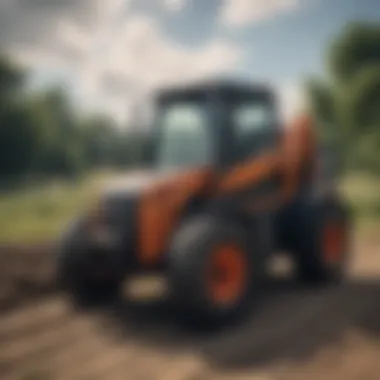
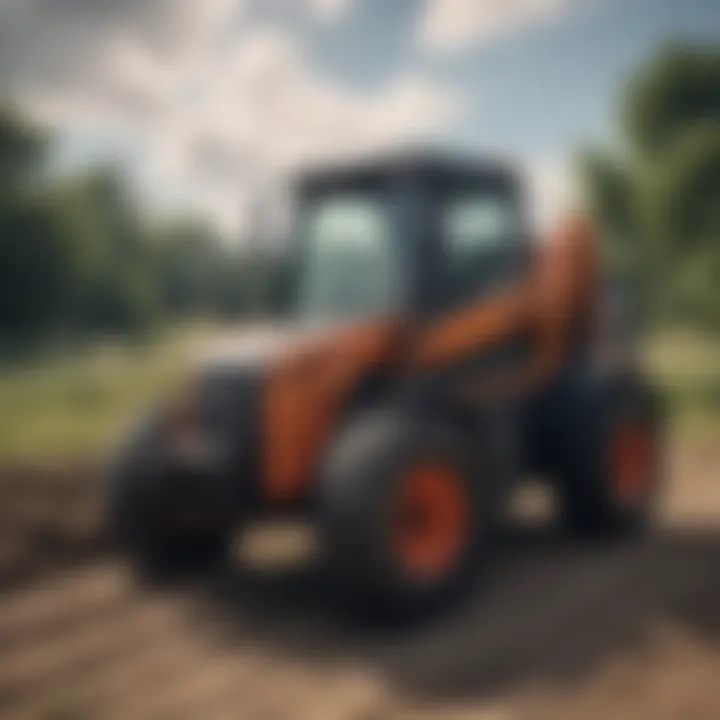
One of the primary benefits of ride along skid steers is their ability to increase productivity on various farming tasks. These machines are equipped with powerful engines and efficient hydraulic systems that allow them to perform heavy lifting and mowing tasks with ease.
- The quick attachment mechanism facilitates swapping out different tools, such as buckets or forks, allowing operators to switch tasks without significant downtime.
- Their compact design enables them to navigate tight spaces, making them ideal for small fields or orchards.
- The high maneuverability of ride along skid steers contributes to faster task completion.
Overall, these features ensure that farmers can maximize the output from their available time and resources, leading to better crop yields or more effective land management.
Operational Versatility
Ride along skid steers are inherently versatile, making them suitable for a range of agricultural applications. This versatility allows farmers to use a single machine for multiple tasks, thus reducing the need for a fleet of specialized equipment.
- They can be used for soil preparation, seeding, harvesting, and even transporting materials across the farm.
- With various attachments available, the functionality of skid steers can be easily expanded. Tasks ranging from brush clearing to snow removal can be performed with the appropriate tool.
- The flexibility in operations enables farmers to respond to changing agricultural demands throughout the year.
In summary, this adaptability addresses the diverse needs faced by farmers today, making ride along skid steers a valuable asset in many agricultural environments.
Labor Efficiency
Ride along skid steers contribute significantly to labor efficiency in agricultural tasks. By combining the capabilities of various implements, these machines reduce the amount of manual labor required while enhancing output.
- The need for fewer workers to accomplish the same tasks leads to cost savings in labor.
- With automated controls and easy maneuverability, even less experienced operators can quickly become proficient in using these machines.
- The reduction in strain on workers' bodies can lead to fewer injuries, thus promoting a safer workplace.
Ultimately, ride along skid steers represent an effective solution in streamlining operations and improving safety, allowing farmers to focus on more strategic aspects of their operations.
"Ride along skid steers are reshaping the way activities are conducted on farms, leading to increased yield and labor efficiency."
This section synthesizes the practical benefits of ride along skid steers, highlighting their impact on productivity, versatility, and labor efficiency. As modern agriculture continues to evolve, understanding these advantages becomes paramount for making informed decisions regarding equipment investments.
Safety Considerations
Safety is a critical aspect to consider when operating ride along skid steers. Given the machinery's powerful capabilities and various operational environments, ensuring safety can prevent accidents and maintain productivity. This section will detail operator safety measures and equipment safety standards that are important for anyone using these machines.
Operator Safety Measures
Operators of ride along skid steers must adhere to strict safety protocols to ensure their well-being. Key measures include:
- Personal Protective Equipment (PPE): Wearing appropriate PPE is essential. This includes hard hats, safety goggles, ear protection, and steel-toed boots. Each piece of equipment protects against potential hazards on the job site.
- Training: Comprehensive training should be mandatory for all operators. Proper training not only covers the technical aspects of operating the skid steer but also emphasizes safety practices in various scenarios. Understanding the machine's limits and capabilities is crucial.
- Pre-Operation Checks: Operators should always perform a thorough inspection before starting the machine. This involves checking hydraulic systems, brakes, and other critical components. Ensuring these elements are in good working order can prevent breakdowns and accidents.
- Stable Operating Surface: When using a skid steer, ensuring a level and stable surface is vital. Operating on loose or unequal ground can lead to loss of control and potential rollovers.
"Operator awareness and adherence to safety practices are fundamental to preventing incidents during skid steer operations."
These practices can significantly reduce operator risk during work with skid steers. Proper measures enhance safety and contribute to overall efficiency by minimizing downtime due to accidents.
Equipment Safety Standards
Adhering to equipment safety standards is just as vital as implementing operator measures. These standards serve as guidelines to ensure machinery is safe to operate. Key standards include:
- Manufacturer Guidelines: All operators and maintenance personnel must follow the manufacturer's instructions regarding the safe operation of the skid steer. This includes load limits and operational protocols during adverse weather conditions.
- Maintenance Protocols: Regular maintenance must be conducted on the equipment to keep it in optimal condition. This includes checks on hydraulic fluids, engine performance, and tire conditions. Inadequate maintenance can lead to equipment malfunction, creating risky situations on the job site.
- Emergency Procedures: Operators should be familiar with emergency shutdown procedures. Quick action can prevent accidents and mitigate damages if something goes wrong during operation.
- Safety Features: Modern skid steers come equipped with various safety features such as roll-over protection systems (ROPS) and restraint systems. Understanding and utilizing these features can enhance safety further.
Maintaining a focus on these equipment standards is essential for all stakeholders involved in the use of ride along skid steers. This conscientious approach fosters a safer work environment and reinforces efficient operational practices.
Maintenance Practices
Effective maintenance practices are critical in ensuring the longevity and operational efficiency of ride along skid steers. These sophisticated machines are integral to various agricultural tasks, and regular upkeep can significantly enhance productivity. By focusing on specific maintenance elements, operators can manage wear and tear, ensure safety, and maintain functionality.
Routine Inspections
Routine inspections form the backbone of effective maintenance for ride along skid steers. These scheduled check-ups allow operators to identify potential issues early before they escalate into more significant problems. Regular inspection includes checking fluid levels – oil, coolant, and hydraulic fluids – to ensure optimal performance.
Key components to inspect include:
- Tires: Ensure that they are adequately inflated and free from damage.
- Belts and Hoses: Look for signs of wear, cracks, or leaks.
- Battery Terminals: Keep them clean and check for corrosion.
These procedures should occur at regular intervals to align with operational demands. Operators should document these inspections to create a maintenance history, which can help in identifying recurring problems or patterns that may need addressing.
Common Repairs
Despite the best maintenance practices, repairs will be necessary from time to time. Being familiar with common repairs can save time and reduce downtime on the farm. Some typical repairs might include:
- Hydraulic System Repairs: Hydraulic issues could arise due to leaks or pressure loss. Addressing these problems quickly is essential as they directly impact machine performance.
- Engine Repair: The engine might develop problems such as overheating or lack of power. Regular checks can mitigate these risks, but having a plan for engine repair can minimize disruptions.
- Electrical System Issues: Wiring damage or electrical faults can impede functionality. Identifying these issues during routine inspections can prevent operational delays.
Understanding both routine inspections and common repairs equips operators to maintain ride along skid steers effectively. Regular maintenance not only extends the life of the equipment but also enhances overall productivity on the farm. Operators of ride along skid steers should prioritize systematic upkeep to ensure these powerful machines function optimally, safeguarding their investment in agricultural operations.
“Preventative maintenance is not just about fixing problems; it's about preventing them altogether.”
Maintaining ride along skid steers is an ongoing process that requires diligence and commitment. Being proactive about maintenance will lead to smoother operation, allowing farmers to focus on their core activities.
Technological Innovations
Technological innovations in ride along skid steers are transforming the agricultural landscape. These advancements not only enhance the functionality and safety of the machines but also significantly improve their efficiency in various farming practices. Understanding these innovations is crucial for both farmers and enthusiasts aiming to optimize their operations.
Automation in Operations
The implementation of automation in ride along skid steers has revolutionized how agricultural tasks are completed. Automation enables these machines to carry out precise movements and tasks without constant human intervention.
- Increased precision: Automated systems can improve accuracy in tasks such as planting, cultivating, and even harvesting. This leads to better crop yields and minimizes waste.
- Reduced labor costs: With automation, the reliance on manual labor decreases. Operators can manage multiple machines simultaneously, reducing the need for a large workforce.
- Consistency and reliability: Automation ensures that each task is performed uniformly. This reliability is key to maintaining quality in agricultural operations.
Incorporating automation technology might involve using GPS-guided systems to navigate fields more efficiently. Additionally, it allows for data collection which can help in making informed decisions regarding crop management.
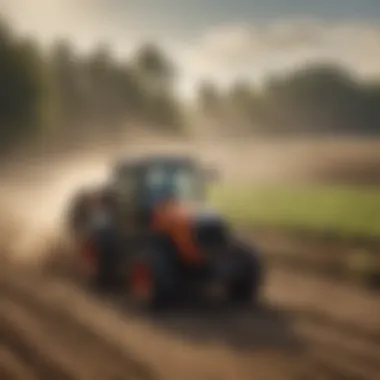
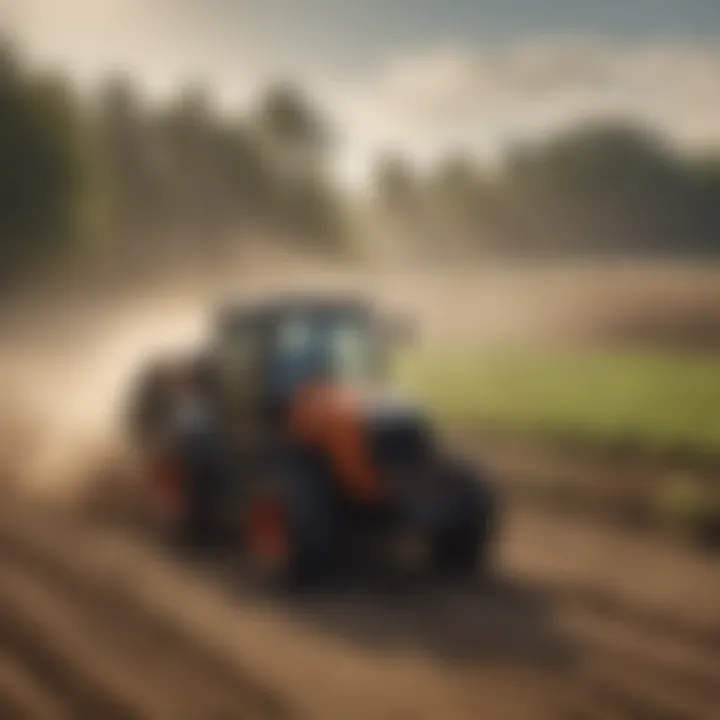
Integration with Precision Agriculture
Precision agriculture is another significant technological trend that complements the use of ride along skid steers. This approach focuses on utilizing data and technology to optimize field-level management regarding crop farming. There are several benefits to integrating precision agriculture with skid steer operations:
- Data-driven decisions: By employing sensors and imaging technology, farmers can gather detailed information about soil health, moisture levels, and crop conditions. This data allows for more strategic planning of operations.
- Resource efficiency: Integration helps in reducing the use of water, fertilizers, and pesticides. Skid steers can be equipped with precision application tools, ensuring these resources are used where and when they are needed.
- Time savings: Real-time data allows farmers to schedule tasks at the most opportune moments, thus applying timely interventions.
The synergy between automation and precision agriculture signifies a leap forward for the agricultural sector. As technology continues to progress, it is essential for farmers to stay updated on these trends to maintain competitiveness.
"The future of agriculture hinges on the harmonious blend of technology and traditional practices. Ride along skid steers exemplify this evolution."
Comparative Analysis with Other Equipment
Comparing ride along skid steers to other types of equipment is essential for farmers making equipment decisions. Each machine serves unique functions, and understanding these differences can improve operational efficiency. This section explores the comparative merits and drawbacks of ride along skid steers against two popular alternatives: compact track loaders and traditional tractors.
Skid Steer vs. Compact Track Loader
Both skid steers and compact track loaders share similarities in design and function, but there are key differences to consider.
- Mobility and Terrain Adaptability: Skid steers are highly maneuverable, ideal for tight spaces. They perform excellently on firm surfaces. However, compact track loaders have wider tracks that distribute weight better, allowing them to work on soft ground and uneven surfaces without risking damage or sinking.
- Safety and Stability: Safety is critical when operating heavy machinery. Skid steers are generally less stable on slopes, while compact track loaders provide better stability due to their lower center of gravity and wider stance. This stability can enhance operator confidence, particularly in challenging environments.
- Costs and Maintenance: When it comes to cost, skid steers are often less expensive both to purchase and maintain compared to compact track loaders. The simpler design of skid steers usually results in lower maintenance requirements.
Skid Steer vs. Traditional Tractors
Comparing ride along skid steers to traditional tractors reveals significant differences in design and function, each tailored for particular tasks in agriculture.
- Application Versatility: Skid steers are extremely versatile, capable of easily switching attachments for various tasks like loading, digging, or grading. In contrast, while tractors may also use attachments, they are typically better suited for larger-scale operations like plowing, planting, and towing heavier loads.
- Size and Space Management: Skid steers offer a compact size, making them ideal for operations requiring movement in tight or confined spaces. Traditional tractors, on the other hand, take up more space but offer advantages related to pulling power and connectivity with larger implements.
- Fuel Efficiency and Performance: Generally, skid steers have smaller engines, leading to better fuel efficiency when performing light to medium tasks. Traditional tractors, while being less fuel-efficient in some situations, excel in heavy-duty operations requiring substantial horsepower.
In summary, the best choice depends on the tasks at hand. Skid steers shine in maneuverability and attachment versatility, while traditional tractors are indispensable for their scaling capabilities and pulling power.
Ultimately, understanding these differences allows agriculture professionals to make informed decisions that enhance productivity and operational efficiency.
"Choosing the right equipment is crucial. It's not about which is better, but which one meets your specific needs.”
The considerations covered above are vital for forming a comprehensive overview of ride along skid steers in contrast to other equipment types, demonstrating how a detailed analysis can augment operational decision-making in the agricultural sector.
Case Studies
Case studies provide a real-world perspective on the effectiveness and efficiency of ride along skid steers in agriculture. These examples highlight how specific farms have implemented these machines to address their unique challenges, ultimately benefiting from increased productivity and streamlined operations. Analyzing these cases reveals practical insights into best practices, challenges faced during adoption, and the strategies that led to successful integration. This helps both large-scale and small-scale farmers make informed decisions regarding their equipment choices.
Successful Implementation in Large Farms
Large farms often require significant machinery to manage vast expanses of land. The integration of ride along skid steers into their operations has proven invaluable. For instance, a large grain farm in the Midwest adopted ride along skid steers to enhance soil preparation and crop maintenance. The key aspects that contributed to their successful implementation include:
- Versatility: The ability to attach various implements greatly improved the speed and efficiency of tasks ranging from tilling to harvesting.
- Cost Efficiency: By reducing the labor needs for certain operations, the farm realized a substantial decrease in operational costs.
- Time Management: The agility and maneuverability of skid steers allowed operations to be conducted in less time, facilitating faster planting and harvesting cycles.
Such tangible benefits often lead large farmers to adopt ride along skid steers, thus reshaping their operational methods and allowing them to meet market demands more effectively.
Impact on Small-Scale Operations
Even on smaller farms, the presence of ride along skid steers has not gone unnoticed. These machines can significantly enhance productivity while alleviating the physical demands on operators. A small organic farm focused on sustainable practices adopted a ride along skid steer for these reasons:
- Reduction of Physical Strain: Tasks that typically required substantial manual labor, such as moving compost or preparing planting beds, became more manageable with the machine’s assistance.
- Precision Agriculture: Smaller farms benefit from the ability to operate with higher precision, improving crop yields while minimizing waste.
- Scalability: Small farms that might once have felt limited in their expansion options have found that effective use of skid steers allows for gradual growth without significant upfront investments.
Overall, the impact of ride along skid steers is notable on both ends of the farm spectrum. These case studies illustrate their versatility and benefits, paving the way for modern agricultural practices that adapt to the unique needs of the industry.
Future Trends in Ride Along Skid Steers
Understanding future trends in ride along skid steers is vital for grasping how agriculture will evolve in the next few years. The integration of innovative technologies can significantly enhance the efficiency and productivity of farming operations. Electric models are gaining attention for their potential to reduce emissions and operational costs. Additionally, advancements in connectivity and data usage present farmers with unprecedented insights into their machinery and operational metrics.
This section will explore two important aspects shaping the future of ride along skid steers in agriculture.
Adoption of Electric Models
The shift towards electric models in ride along skid steers represents a transformative trend. Electric skid steers promise several benefits:
- Reduced Emissions: They offer a cleaner alternative to diesel engines, which is crucial for sustainable farming practices.
- Lower Operating Costs: Electric models often have lower maintenance costs due to fewer moving parts and less need for fuel supply management.
- Noise Reduction: Many electric machines operate more quietly, which can be beneficial in noise-sensitive environments, such as urban farming operations.
Key manufacturers are investing heavily in electric technology. This investment indicates a growing confidence in electric models' viability for widespread agricultural use.
Advancements in Connectivity and Data Usage
The rise of IoT (Internet of Things) technology enhances connectivity in ride along skid steers. This trend encourages the collection of valuable data during operations. The implications are significant:
- Operational Efficiency: Farmers can monitor performance metrics in real-time, allowing for timely adjustments that can improve efficiency.
- Predictive Maintenance: By analyzing data, operators can anticipate potential equipment failures, leading to reduced downtime and maintenance costs.
- Precision Agriculture: Connectivity enables the integration of GPS and GIS technology, facilitating better land management and resource allocation.
In summary, the future trends within the realm of ride along skid steers focus on eco-friendliness through electric models and the empowerment of farmers through data connectivity. Both elements are not just innovations, but essentials for meeting the demands of modern agriculture.
Closure
In this article, we explored the operational significance of ride along skid steers in modern agriculture. These versatile machines have transformed farming practices through their unique ability to enhance efficiency and productivity across various tasks. Understanding the importance of ride along skid steers is crucial for farmers looking to optimize their operations.
Summary of Key Points
- Key Characteristics: Ride along skid steers are known for their compact design, powerful engines, and efficient hydraulic systems. This design allows them to perform various agricultural tasks, from soil preparation to harvesting.
- Diverse Applications: The versatility of skid steers is seen in their applications. They are employed in land preparation, maintenance, and harvesting, showcasing their adaptability to meet different farm needs.
- Safety and Maintenance: Operator safety and regular maintenance are paramount. Proper training in safety measures can reduce the risk of accidents. Additionally, routine inspections ensure equipment reliability and longevity.
- Technological Advancements: The integration of automation and precision agriculture technologies is shaping the future of ride along skid steers. This trend is likely to further boost operational efficiency and data usage in agricultural settings.
Final Thoughts on Operational Efficiency
Ride along skid steers play a vital role in enhancing operational efficiency within agricultural practices. By streamlining labor-intensive tasks, they allow farmers to focus on more strategic aspects of their operations. The efficiency gains realized through these machines contribute to better crop yields and labor management.
Moreover, as technology continues to advance, ride along skid steers are likely to become even more integral to agricultural processes. Farmers and enthusiasts should remain informed about emerging trends, such as electric models and enhanced data connectivity, to stay ahead in a competitive market.
The investment in ride along skid steers is not just a purchase; it is a strategic move towards future-proofing agricultural operations. Understanding their capabilities and potential impact can provide a significant advantage in both large and small-scale farming environments.



